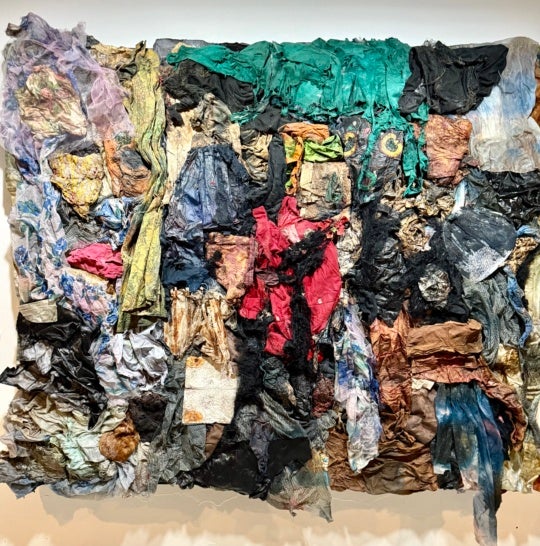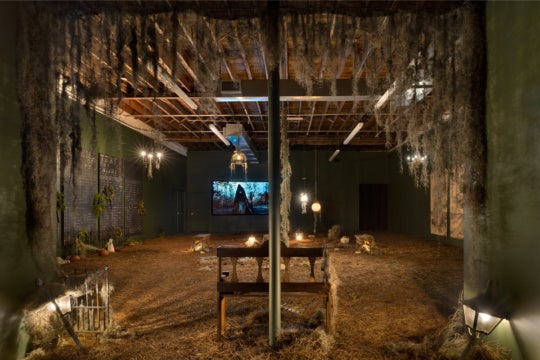
It has been a busy year for Atlanta artist Ashley Anderson. After kicking things off in January with an installation in the Day Job: Georgia show at the Atlanta Contemporary Art Center, Anderson has been a featured artist in the spring issue of Atlanta’s Young, Foxy & Free magazine, taken part in the International Telextext Art Festival in Finland, been featured in the July issue of the UK edition of Wired magazine, suffered and mostly recovered from a severe injury to his left foot, all while having artwork in at least one local gallery at nearly any given time. My point is: Ashley Anderson is everywhere.

I have been following Anderson’s work for some time now, so when I caught wind that he was having his first solo exhibition at Emily Amy Gallery, titled Shinobi Marilyn, my first reaction was pure excitement; my second was, “what is a Shinobi Marilyn?” To find out, I visited the artist at his home studio.
The place had been almost entirely consumed by artwork for the show. The walls were covered with paintings in various states of completion; drawings taped to makeshift foam-core drawing boards were piled on tables and poking out from behind desks; and images of Marilyn Monroe surrounded me completely—her pixelated but sultry countenance gazing benignly back at me from every visible surface. But what were the shimmering gold squares that made up her eyes asking me?

For the next two hours, like a delightfully crazed conspiracy theorist, Anderson took me from the origins of the Shinobi Marilyn project to the huge variety of artwork that he has made, and all of the mysterious and inexplicable tangents in between. I followed up with Anderson over email to synthesize our conversation, but there’s simply way too much to say about Shinobi Marilyn than can be contained by five questions.

Henry Detweiler: First off, for those of us not in the loop, what is Shinobi?
Ashley Anderson: Shinobi is an arcade video game originally released in November 1987. It was such a success in arcades that Sega created home console conversions for 10 consoles on the market at the time: from the familiar Nintendo Entertainment System and Sega Master System to more unfamiliar machines like the ZX Spectrum and the TurboGrafx-16.
Shinobi is a platformer whose main character is a ninja battling various thugs, robots, and evil ninjas. It’s pretty standard, late 80s’ arcade fare.
HD: Could you explain a little about the origins of the Shinobi Marilyn project: how you first came across the imagery and some of the discoveries and connections you’ve made as a result?

AA: I was digging around the internet for images to use in my Memory Beach collages last Summer when I found a collection of screenshots from the arcade version of Shinobi. I was gobsmacked to discover images of Marilyn Monroe plastered all over a wall in the second third of the first level. Mind you, these images have zero bearing on gameplay; if they serve any function, it’s to mark a time and place, for example, America after 1962.

However, I’m not sure those images of Marilyn were placed to serve a narrative function at all. When I began working with the Marilyn images I conducted some independent research into Marilyn’s life and Warhol’s work to establish a context for the images I would create. I discovered an unusual coincidence: on the evening of August 4, 1962 Marilyn Monroe died at her Los Angeles home. Eight miles away that same night, Andy Warhol’s first pop show closed at the Ferus Gallery. Though I’m not trying to say Warhol drove eight miles and killed Marilyn Monroe, I am fascinated by the concurrent ending of Marilyn’s life and beginning of Warhol’s legacy. Furthermore, since Warhol’s Marilyns are perhaps his most iconic work, it seems so strange the event of her death, which initiated his exploration of her power as a symbol, would have occurred the same night his first pop exhibition ended. Her death provided critical fuel to Warhol’s oeuvre, but Warhol’s work in turn elevated Monroe into something eternal, not just another sad Hollywood death.

I also uncovered an unusual coincidence between Warhol’s death and the appearance of his Marilyn images in Shinobi. Warhol died in February of 1987 and Shinobi was released 9 months later. It’s my belief the Shinobi Marilyns are a posthumous tribute to Warhol snuck into the game by one of the designers. It makes sense since most game designers are art students at some point or at the very least are independently engaged in visual art. It is somewhat parallel to Warhol’s original exploration of Marilyn as a symbol, and it adds a whole new generation or removal from the source image, but also another layer of meaning.

I was also surprised at the variety of Marilyn images created for the various home conversions. Since each system has its own unique limitations of color, resolution, memory, and so forth, the visual aspects change from version to version, even if they have a common origin. The weird thing is when I grouped together all the variations I could find I realized some of the home-conversion images of Marilyn are not based on the promotional photo Warhol reproduced in his art. I actually had to contact a Marilyn Monroe memorabilia collector to figure out from which photo several of the Marilyns were being sourced. It turns out the Amiga, Amstrad, and ZX Spectrum conversions of Shinobi used a photo taken by Andre de Dienes in 1956 as their source. What’s even stranger to me, though, is the DOS version of Marilyn, which isn’t based on any photo; it’s a total fabrication, apparently drawn and digitized or drawn directly into the computer when the graphics were being created for the game.
What I want to know is why the images aren’t all sourced from a single photo? Sega didn’t get permission to use any of the images, so copyright doesn’t enter into it. Was it caprice? Did someone lose the scan of the Niagara photo and then confuse it with the 1956 photo? I’ve tried contacting Sega of Japan, but no word yet. I’m really geeking out over this.

I love how Marilyn and 20th Century Fox never knew some artist in New York would buy a photo made to promote Niagara and turn it into some of the most famous art of the last 100 years. I love how Warhol died never knowing a game designer in Japan would inject his work into a video game (I think he would have loved it). I love how the game designer in Japan never knew his work would end up archived on the internet, found 25 years after the fact by some guy in Atlanta who would then turn the imagery right back around from the electric into the physical! It’s crazy!

HD: You’re employing a wide variety of media and processes in creating this show. Could you let us in on some of what went into selecting your media and what we can expect to see in the show?
AA: The first image I created was the image on the show card, one of six Gold Marilyns I’m producing for the show. I had gone to the High Museum and sat with their edition of Warhol’s Marilyn silkscreens, studying the registration, values, sheens, and coloring to get some direction before I started this project. I noticed metallic pigments in one of the prints, and that became a really attractive possibility. It occurred to me to riff on the idea of the Gold Marilyn, which I saw at the MoMA a year ago.

When a likeness such as Monroe’s seems to be everywhere, how does it still contain worth, how is it not irreparably cheapened? Using gold paint to build something that looked valuable but was materially a lie, while taking an alternative tack on the title of an existing artwork, seemed like a funny approach to take; I love humor, so I did that. Then it became a matter of figuring out other ways to subvert the meaning of a Gold Marilyn, so I bought tons of gold art supplies and did tests for opacity, hue, etcetera, and began working out different processes.
I had been doing drawings on plastic and gel transfer prints prior to this project, so I began to think of ways I could play with the Shinobi Marilyns with the qualities of those media and processes. After doing a few pieces I began to recognize certain ideas repeating themselves alongside certain processes. It seems the drawings on plastic are about losing sight or looking directly at something but not really seeing it, and the gel transfers are about manipulating print, somewhat akin to a ransom note vacation to Barbara Kruger’s process. I’m also doing digital collages, drawings on black paper, and I’m waiting on some printed Chinese silk for a sexy racing flag. There’s also an animated GIF!

HD: What attracts you to use the vintage video-game imagery as source material?
AA: I’m still figuring it out, but I can definitely say it has nothing to do with specifically celebrating video games, because I’m not a gamer. Originally, I was using the imagery of games to indicate their expansion of the universal narratives Joseph Campbell found in mythology and religion. My main interest in pixelated imagery, however, has a lot to do with its similarity to the language of painting and my innate, nostalgia-free love of grid imagery. I find a lot of overlap between the visual mechanics of painting and pixelation, but I also find a great capacity for pixelated imagery to relate to a wide variety of ideas completely outside of gaming; though, I certainly exploit the imagery’s reference to the digital and false.
Also, the idea of recycling something as throw-away as game graphics by infusing it with historical reference and various media and techniques has a certain humor about it. It’s also a kind of cultural recycling. The people who created these graphics likely never imagined I would take such an extreme interest in physically manifesting the little bits and pieces they designed to fill out these forgotten environments, and especially not because I detected a capacity in those bits and pieces to create dialogues with art and artists I admire!
There’s an essay written by Lawrence Alloway about Roy Lichtenstein that really explained some of my own interests to me. In particular, Alloway describes Lichtenstein’s use of comic-book imagery as “not a sign of thought suspended, but the shape of thought”; when I read that I just about fell over. That’s what’s up. That whole essay made me fall in love with Lichtenstein, because he’s all about exploring the history of art as well as how that history is constructed right now in the immediate moment of making an image.

HD: How, if at all, has working with the gallery affected the direction you’ve gone with the work?
AA: If anything, the certainty of an exhibition has lit a huge fire under me. I can’t be half ass about this or dilly dally. It’s like that Isely Brothers song: “I Got Work to Do”! If anything, having a space like that to fill has given me the oomph to push around ideas and materials and think “okay, how far can we go down this rabbit hole?”
HD: You’re one of the busiest artists in Atlanta; what have you got coming up next?
AA: I had been working on some non-pixelated illustration projects while I was home with a broken foot, so I’ll probably take a pixelation vacation and knock those out. Also I think my friend Aaron wants to do another crazy animation like the one we did for WonderRoot’s Local Film series, so that should be pretty fun to work on!
In terms of upcoming pixel artwork, there are some flower paintings I started while I was home that I’d like to put some more layers on. I’m still figuring out how to marry painterliness with pixelation and I’ve been looking at a lot of Matisse and Allison Schulnik for guidance with those, so I’m excited to see where they go. I’ve been collecting images of Mount Fuji wherever I can find them in old games and I’m hoping to do a One Hundred and One Views of Mount Fuji sometime soon. I’m also thinking of doing some work about images of wood and glass pulled from games.
Ashley Anderson’s first solo exhibition, Shinobi Marilyn will open at Emily Amy Gallery on Saturday, July 28 with an opening reception from 7 to 10PM, and will remain up through Saturday, September 1, 2012. The gallery is open Tuesdays through Saturdays from 11AM to 5PM.




